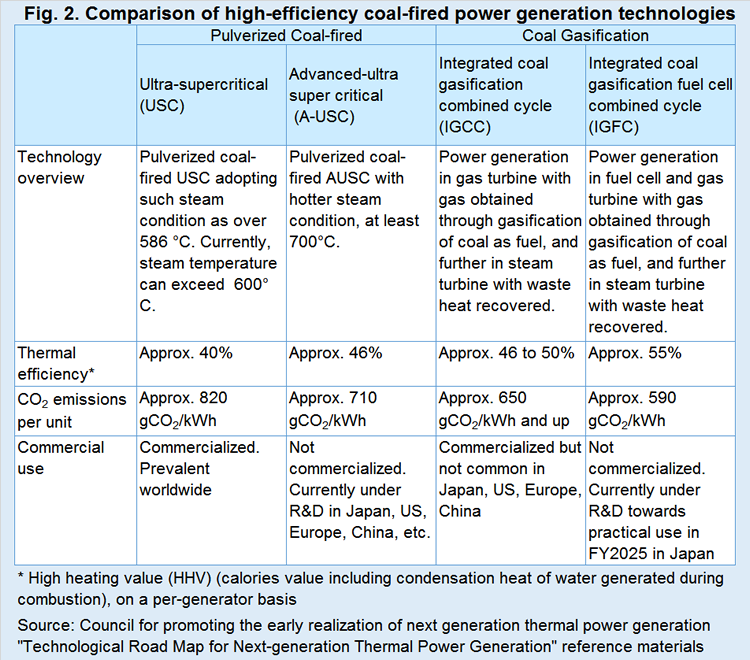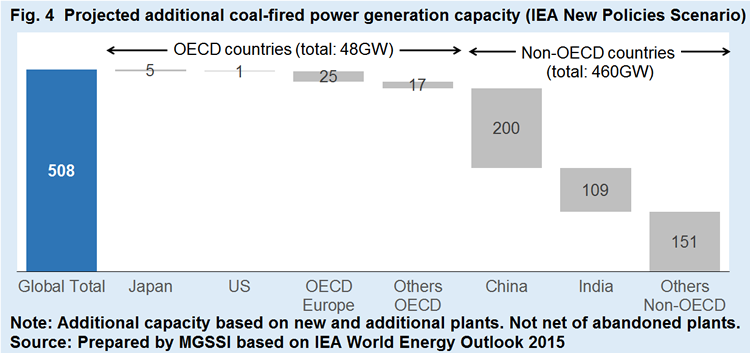Mitsui & Co. Global Strategic Studies Institute
Future Possibilities of Coal-fired Power Generation Based on COP21
Apr. 8, 2016
Yusuke Kikuchi
Technology Studies Dept. I
Mitsui Global Strategic Studies Institute
Main Contents
Coal is characteristically known for its abundance of reserves, territorial distribution, low, stable price, etc., and coal-fired power generation is positioned as an important source of electricity. At the same time, its massive carbon dioxide (CO2) emissions, compared with other power sources, pose a problem.
At the 21st Conference of the Parties (COP) to the United Nations Framework Convention on Climate Change (UNFCCC), held from the end of November 2015, the Paris Agreement was adopted as the first-ever universal, legally binding framework participated in by all the Parties to UNFCCC to reduce greenhouse gas emissions. This agreement specifies the goal of keeping the increase in global average temperature to well below 2°C above pre-industrial levels, along with a challenge to limit the increase to 1.5°C, while referring to the balance between anthropogenic emissions and absorption of greenhouse gases in the second half of this century. Despite remaining concerns as to effectiveness, the agreement gave high hopes for the future progress of the global initiative towards reducing greenhouse gas emissions.
This report overviews the direction of the regulatory tightening of coal-fired power generation as well as the trends of technology development, and explores the future possibilities of coal-fired power generation.
Tougher Regulations Against Coal-fired Power Generation

In recent years, as momentum has continued to grow for greenhouse gas emissions reduction, regulations on coal-fired power generation have been strengthened. In the US and Europe, such trend is remarkable. For example, the levels of restrictions on CO2 emissions implemented by those countries is such that no common coal-fired power plants can be newly established (Fig. 1).
In the UK, the Carbon Price Floor1 has been introduced to set the lower limit on the carbon price, which has disturbed the economics of coal-fired power plants. Before COP 21 was held, the UK’s Secretary of State for Energy and Climate Change, Amber Rudd, announced a plan to restrict the operations of domestic coal-fired power plants from 2023, and close them by 2025. In the US, under the Clean Power Plan (CPP), which sets a CO2 emission reduction target of 32% over the period from 2005 to 2030, each state will be assigned a reduction target, and called on to formulate and implement a reduction plan2.
Moves towards tightening regulations are also seen among emerging countries. The Chinese government hammered out average coal consumption targets of less than 310 g coal/kWh for existing power plants, and less than 300 g coal/kWh for new power plants. In India, the Perform Achieve and Trade (PAT) requires existing power plants to improve thermal efficiency. For new power plants, that requirement will be applied to technologies whose higher thermal efficiency is equal to or higher than supercritical levels3.
In Japan, under the Act on the Rational Use of Energy, new standards for the thermal efficiency of new thermal power plants has been established, and 42% or higher levels4 will be applied to coal-fired power generation. The Law Concerning Sophisticated Methods of Energy Supply Structures requests that electricity retailers procure at least 44% of their supply from non-fossil energy sources in 2030. Both laws are scheduled to be implemented by the end of fiscal 2016.
Multilateral development banks are taking a tough stance as well. In 2013, the World Bank, European Investment Bank, European Bank for Reconstruction and Development, Export-Import Bank of the United States, and Ex-im Bank, in succession, announced plans to impose restrictions on support for coal-fired power generation deals in developing countries. In November 2015, the OECD Working Party on Export Credits and Credit Guarantees continued to allow support for ultra-supercritical (power plant)3 projects, but agreed to the policy to restrict support for supercritical and subcritical3 projects. This agreement includes a provision to review the content by June 2019, considering scientific knowledge and technology development trends regarding the 2 °C target. In the future, even tougher regulations may be implemented.
Initiatives Towards Reducing CO2 Emissions from Coal-fired Power Generation

Increasing the efficiency of coal-fired power generation is one of the measures to reduce CO2 emissions. Figure 2 is a typical example of coal-fired power generation technologies. The world’s average CO2 emissions per unit of electricity generated by coal is estimated at more or less 1,000 g CO2/kWh 5, and the high-efficiency technologies listed in the table make it possible to reduce CO2 emissions per unit of electricity generated by approximately 20% to 40%.
However, this estimation as to reduction is solely for the purpose of comparison between the types of coal-fired power generation, far from the level of the natural gas turbine combined cycle (CO2 emissions per unit: approximately 350 g CO2/kWh). Drastic reduction of CO2 from coal-fired power generation requires the process of capturing and storing CO2 (carbon capture and storage: CCS). In October 2014, the world’s first CCS project capturing CO2 from a coal fired power plant on a commercial scale was launched in Canada, and subsequently in the US, two new projects are scheduled for 2016. CCS projects are being increasingly implemented, but it is still a long way to go until CCS is fully deployed, mostly due to: (1) high costs; (2) slumping carbon prices; (3) insufficiently developed institutions; (4) difficulty in forming social consensus.
Anti-Climate Change Scenario, Future Coal-fired Power Generation
Although circumstances surrounding coal-fired power generation are becoming increasingly severe, it will remain an essential source of power for the time being. It is considered that a sharp drop should be rather exceptional, and that more new plants will be established in emerging countries.
Figure 3 shows 2013 and 2040 data from IEA’s World Energy Outlook 2015 on coal-fired power generation – its output, annual growth rate, and share in total power generation in 2013 and 2040. For 2040, the New Policies Scenario, which is the baseline scenario of the IEA (already introduced or under review in each country), is represented along with the 450 Scenario (which sets out the goal of limiting the global increase in temperature to 2°C by limiting the concentration of greenhouse gases in the atmosphere to around 450 ppm of CO2). In the New Policies Scenario, coal-fired power generation will remain positioned as an important source of power as of 2040, however, on different levels among countries and regions. In particular, China and India increased power generation output, maintaining nearly a 50% share. On the other hand, in the 450 Scenario, both the output and share will fall significantly in all countries and regions. It is true that enhanced climate change measures have a great impact on coal-fired power generation.

That said, the current status is largely different from the 450 Scenario. Ahead of COP21, each country has submitted an Intended Nationally Determined Contribution (INDC) including reduction targets from 2020 onward to the UNFCCC Secretariat. According to the analysis of the Secretariat, the world’s 2030 greenhouse gas emissions when all countries’ INDCs combined will exceed the 2°C Scenario by 15.1 billion CO2 equivalent per year. The Paris Agreement, however, does not require the Parties to achieve their reduction targets or raise their targets because its priority is the participation of the US and emerging countries. In this situation, it is considered unlikely that each country will immediately raise its reduction target despite its energy state or economic conditions. This Agreement stipulates the submission of reduction targets (the next target for 2030 to be submitted by 2020) and the evaluation on progress (the global stocktake: the first evaluation scheduled for 20236) on a five-year basis. Repetition of this cycle is expected to encourage each country to voluntarily raise its own target7.

For the near term, each country will probably promote realistic reduction measures based on its own state. In emerging countries, “the reduction of CO2 emissions by utilizing the higher efficiency of coal-fired power generation” is a realistic measure. Actually, China and India included the promotion of high efficiency in coal-fired power generation as a measure in their INDCs. The INDCs of both countries are designed from the perspective of 2030. It is projected that coal-fired power generation will remain in use, mostly in these emerging countries, with higher efficiency and additional production capacity. (Fig. 4)
In the future, all countries, including emerging countries, may raise their reduction targets significantly, thus causing coal-fired power generation to fall sharply. However, at this point, it should be regarded as a long-term issue in the perspective of 2030 and thereafter. The Paris Agreement calls on each country to submit by 2020 long-term low greenhouse gas emission development strategies as well as its 2030 target. How will each country draw up a long-term scenario? The year 2020 is a turning point. We should stay focused on this issue.
- The government sets the floor limit of carbon prices, and levies the difference from the price determined under the European Union Emission Trading Scheme (EU ETS). The tax from fiscal year 2016 onwards will be 18 pounds/tCO2.
- After the CPP was published in a newsletter on October 23, 2015, 26 states and companies filed a complaint over its legality, seeking to postpone the implementation of the CPP until the lawsuit is settled. On February 9, 2016, the Supreme Court ruled to postpone the implementation of the CPP.
- Supercritical refers to steam with a temperature up to 566 °C and pressure of at least 22.1 MPa. Supercritical with a steam temperature in excess of 566 °C is called ultra-supercritical pressure. Steam pressure of less than 22.1 MPa is called sub-critical.
- High heating value (HHV) (calorific value including condensation heat of water generated during combustion), on a per-generator basis
- Calculated using the world’s output and CO2 emissions from coal-fired power generation, according to the IEA World Energy Outlook 2015 (both from 2013 data).
- Only mitigation (total reduction evaluation, progress confirmation) is to be launched in 2018 (facilitative dialogue).
- Scientific knowledge on climate sensitivity (the increase in temperature when the concentration of greenhouse gas doubles) leaves uncertainty; the impact on setting emission allowances should be noted.